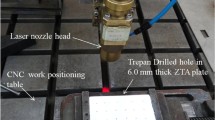Abstract
Quality and throughput of laser material processing are influenced by multiple laser parameters as well as material properties. Since material degradation due to laser processing is generally related to heat-affected zone, quick optimization and realization of nonthermal process is one of the most important issues for higher-grade laser processing. In this work, we developed various parameter-controlled ultrashort pulse laser system that can control various laser parameters over a wide range, such as pulse duration over three orders of magnitude. Using this laser system (wavelength: 1033 nm, pulse duration: 0.4 to 400 ps, repetition: up to 1 MHz), we have investigated nonthermal–thermal processing boundary in drilling of ceramics: aluminum nitride (AlN) and yttria-stabilized zirconia (YSZ), with high and low thermal conductivity, respectively. As a result, the AlN ceramic exhibited strong dependence of ablation rate on fluence: low-, mid- and high-fluence regimes appeared with different logarithmic correlations. Further, the nonthermal–thermal process boundaries appeared, depending on the pulse duration. On the other hand, the ablation behavior of YSZ was much different from AlN; the ablation rate did not show distinct three regimes. Further, there were no nonthermal process windows for the YSZ. Therefore, the nonthermal–thermal process boundaries were governed by the laser parameters like pulse duration as well as the material thermal conductivity.







Similar content being viewed by others

References
S. Preuss, E. Matthias, M. Stuke, Sub-picosecond UV-laser ablation of Ni films: strong fluence reduction and thickness-in-dependent removal. Appl. Phys. A 59, 79–82 (1994)
B.N. Chichkov, C. Momma, S. Nolte, F. von Alvensleven, A. Tünnermann, Femtosecond, picosecond and nanosecond laser ablation of solids. Appl. Phys. A 63, 109–115 (1996)
T.V. Kononenko, V.I. Konov, S.V. Garnov, R. Danielius, A. Piskarskas, G. Tamoshauskas, F. Dausinger, Comparative study of the ablation of materials by femtosecond and pico- or nanosecond laser pulses. Quantum Electron. 29, 724–728 (1999)
M. Hashida, H. Mishima, S. Tokita, S. Sakabe, Non-thermal ablation of expanded polytetrafluoroethylene with an intense femtosecond-pulse laser. Opt. Express 17, 13116–13121 (2009)
J. Byskov-Nielsen, J.M. Savolainen, M.S. Christensen, P. Balling, Ultra-short pulse laser ablation of copper, silver and tungsten: experimental data and two-temperature model simulations. Appl. Phys. A 103, 447–453 (2011)
N. Ackerl, M. Warhanek, J. Gysel, K. Wegener, Ultrashort-pulsed laser machining of dental ceramic implants. J. Eur. Ceram. Soc. 39, 1635–1641 (2019)
F. Korte, S. Adams, A. Egbert, C. Fallnich, A. Ostendorf, Sub-diffraction limited structuring of solid targets with femtosecond laser pulses. Opt. Express 7, 41–49 (2000)
G. Miyaji, K. Miyazaki, Origin of periodicity in nanostructuring on thin film surfaces ablated with femtosecond laser pulses. Opt. Express 16, 16265–16271 (2008)
G.D. Tsibidis, C. Fotakis, E. Stratakis, From ripples to spikes: a hydrodynamical mechanism to interpret femtosecond laser-induced self-assembled structures. Phys. Rev. B 92, 041405 (2015)
A. Narazaki, J. Nishinaga, H. Takada, T. Sato, H. Niino, K. Torizuka, Y. Kamikawa-Shimizu, S. Ishizuka, H. Shibata, S. Niki, Evaluation of femtosecond laser-scribed Cu(In, Ga)Se2 solar cells using scanning spreading resistance microscopy. Appl. Phys. Express 11, 032301 (2018)
J. Finger, M. Reininghaus, Effect of pulse to pulse interactions on ultrashort pulse laser drilling of steel with repetition rates up to 10 MHz. Opt. Express 22, 18790–18799 (2014)
C. Kerse, H. Kalaycıoğlu, P. Elahi, B. Çetin, D.K. Kesim, Ö. Akçaalan, S. Yavaş, M.D. Aşık, B. Öktem, H. Hoogland, R. Holzwarth, F.Ö. Ilday, Ablation-cooled material removal with ultrafast bursts of pulses. Nature 537, 84–88 (2016)
J. Mur, R. Petovsek, Near-THz bursts of pulses–Governing surface ablation mechanisms for laser material processing. Appl. Surf. Sci. 478, 355–360 (2019)
R. Weber, T. Graf, P. Berger, V. Onuseit, M. Wiedenmann, C. Freitag, A. Feuer, Heat accumulation during pulsed laser materials processing. Opt. Express 22, 11312–11324 (2014)
F. Bauer, A. Michalowski, T. Kiedrowski, S. Nolte, Heat accumulation in ultra-short pulsed scanning laser ablation of metals. Opt. Express 23, 1035–1043 (2015)
A. Gruner, J. Schille, U. Loeschner, High repetition frequency micro hole drilling of metal foils using ultrashort pulse laser radiation. Proc. SPIE 10520, 105200R (2018)
D. Yoshitomi, H. Takada, K. Torizuka, Y. Kobayashi, 100-W average-power femtosecond fiber laser system with variable parameters for rapid optimization of laser processing, in Conference on Lasers and Electro-Optics OSA Technical Digest (Optical Society of America), paper SM3L.2 (2019)
Y. Hirayama, H. Yabe, M. Obara, Selective ablation of AlN ceramic using femtosecond, nanosecond, and microsecond pulsed laser. J. Appl. Phys. 89, 2943–2949 (2001)
S.H. Kim, T. Balasubramani, I.B. Sohn, Y.C. Noh, J. Lee, S. Jeong, Precision microfabrication of AlN and Al2O3 ceramics by femtosecond laser ablation. Proc. SPIE 6879, 68791 (2008)
V. Nasrollahi, P. Penchev, T. Jwad, S. Dimov, K. Kim, C. Im, Drilling of micron-scale high aspect ratio holes with ultra-short pulsed lasers: critical effects of focusing lenses and fluence on the resulting holes’ morphology. Opt. Lasers Eng. 110, 315–322 (2018)
S. Nolte, C. Momma, H. Jacobs, A. Tuennermann, B.N. Chichkov, B. Wellegehausen, H. Welling, Ablation of metals by ultrashort laser pulses. J. Opt. Soc. Am. B 14, 2716–2722 (1997)
J. Schille, L. Schneider, U. Loeschner, Process optimization in high-average-power ultrashort pulse laser microfabrication: how laser process parameters influence efficiency, throughput and quality. Appl. Phys. A 120, 847–855 (2015)
T.H.R. Crawford, H.K. Haugen, Sub-wavelength surface structures on silicon irradiated by femtosecond laser pulses at 1300 and 2100 nm wavelengths. Appl. Surf. Sci. 253, 4970–4977 (2007)
Acknowledgements
This work was financially supported by the New Energy and Industrial Technology Development Organization (NEDO).
Author information
Authors and Affiliations
Corresponding author
Additional information
Publisher's Note
Springer Nature remains neutral with regard to jurisdictional claims in published maps and institutional affiliations.
Rights and permissions
About this article
Cite this article
Narazaki, A., Takada, H., Yoshitomi, D. et al. Study on nonthermal–thermal processing boundary in drilling of ceramics using ultrashort pulse laser system with variable parameters over a wide range. Appl. Phys. A 126, 252 (2020). https://doi.org/10.1007/s00339-020-3410-2
Received:
Accepted:
Published:
DOI: https://doi.org/10.1007/s00339-020-3410-2



